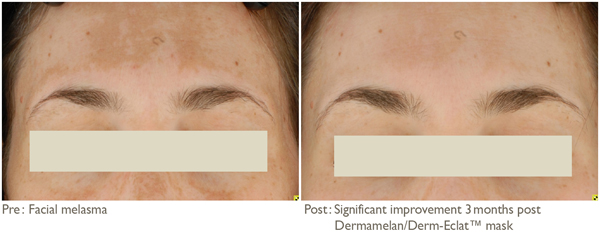
Chemical Peels
Chemical peel is helpful for wrinkles, light acne scarring and irregular pigmentation such as freckles and age spots. Pre-cancerous conditions such as keratoses (thick, rough, reddish growths) also respond well to this procedure.This procedure destroys parts of the skin in a controlled way so that new skin can grow in its place. The chemicals used are sometimes called exfoliating or wounding agents.

Glycolic Peel
Minimize the appearance of fine lines and wrinkles with this intensive exfoliating procedure that stimulates the collagen and causes non-abrasive exfoliation of dead skin cells accumulated on the surface of the skin.

How does the Dermamelan treatment work?
The Dermamelan works to reduce the pigmentation by blocking the tyrosinase enzyme that is responsible for the production of pigmentation in the skin. The Dermamelan is able to regulate the amount of melanin pigment that is formed in the skin and exfoliate the dark visible pigmentation which evens out the skins tone and reduces the hyperpigmentation.
WHICH CONDITIONS CAN IT BE USED TO TREAT?
Dermamelan is a depigmentation agent used to treat the following skin conditions:
• Melasma - patchy or generalised dark pigmentation of the skin.
• Chloasma - patchy brown or dark brown skin discoloration that usually occurs on a woman's face and may result from hormonal changes e.g. pregnancy and the contraceptive pill.
• Lentigo small, sharply circumscribed, pigmented spot.
• Post- inflammatory hyper pigmentation
ADDITIONAL BENEFITS OF DERMAMELAN
Dermamelan also provides skin beautification:
• It improves the signs of photo-aging and photo-damage of the skin
• It regulates sebaceous secretion especially in mixed and greasy skins
• It reduces pore size and can prevent spots from appearing
WHAT IS THE TREATMENT LIKE?
Your skin will be prepared with an alcohol based solution to remove all the grease/sebaceous secretions from your skin. The Dermamelan cream mask (which is brown/yellow in colour) will then be applied to your skin. There should be no discomfort or irritation to the skin while the mask is on. You will leave the clinic with the cream mask on so a suitable mode of transport home should be organised in advance public transport is not advisable. After a specified time you will be told to remove the cream mask and follow the written after-care instructions provided.
AFTER THE TREATMENT
Dermamelan is a very safe procedure however some common side effects should be anticipated.
• Skin tightness: For a day or two after the Dermamelan cream mask is removed the skin may feel tight and may look very slightly swollen.
• Skin redness: After the mask is removed and during the initial period of using Dermamelan maintenance cream at home, the face may appear red. The degree of redness will depend on your natural skin colouring and sensitivity to the treatment.
• Skin Flaking/Peeling: During the first week after the Dermamelan mask treatment you should expect some skin flaking or peeling. The degree of skin exfoliation is highly variable and therefore some patients choose to take a few days off work while the initial effects of the treatment settle. Hydra-Vital factor K moisturiser (supplied by our clinic) can be applied to relieve any skin discomfort during this time. During the course of the continued treatment with Dermamelan maintenance cream you may also experience some skin flaking and/or redness. This usually settles as the skin builds up tolerance to the treatment.
HOW MANY TREATMENTS WILL I NEED?
The face mask is generally applied only once. The home application of Dermamelan will continue for several months as advised by your doctor.
WHEN WILL I SEE A RESULT?
Depending on the severity of your pigmentation you will begin to see an improvement after 2-8 weeks. You will be advised on how to use the home-care products and for how long to prevent the pigmentation from recurring. The daily use of a moisturising sunscreen is essential.


